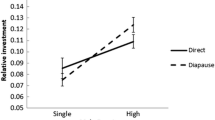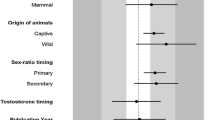Abstract
Investment into reproduction is influenced by multiple factors and varies substantially between males and females. Theory predicts that males should adjust their ejaculate size or quality in response to variation in female experience or phenotypic quality. In addition, sperm investment by males may also be influenced by their own status and experience. Although such adjustments of male ejaculate size can impact reproductive success (via fertilization success), fitness returns from male sperm investment may be influenced (either limited or facilitated) by the level of maternal investment. To test this hypothesis, we conducted an experiment that simultaneously evaluated the effect of paternal and maternal experience (which incorporates mating status, age, body size, and other related variables) on paternal sperm investment and maternal reproductive allocation in the lizard Anolis sagrei. During staged mating trials, experienced males were more likely to copulate with females, but these individuals were less likely to transfer sperm during mating than were naïve individuals. Maternal experience had no impact on these mating behaviors. In contrast to expectations, experience and phenotypic quality (of both sexes) had no impact on male ejaculate size or quality (proportion of live sperm) or on maternal reproductive investment (in terms of egg size and yolk steroids). These findings were intriguing given the mating system and past evidence for differential maternal investment in relation to sire quality in A. sagrei. The results found in this study highlight the complexity of reproductive investment patterns, and we urge caution when applying general conclusions across populations or taxa.


Similar content being viewed by others
References
Armstrong JA, Gamble HJ, Goldby F (1953) Observations on the olfactory apparatus and the telencephalon of Anolis, a microsmatic lizard. J Anat 87:288–307
Blanckenhorn WU (2000) Temperature effects on egg size and their fitness consequences in the yellow dung fly Scathophaga stercoraria. Evol Ecol 14:627–643
Bonduriansky R (2001) The evolution of male mate choice in insects: a synthesis of ideas and evidence. Biol Rev 76:305–339
Brooks R, Kemp DJ (2001) Can older males deliver the good genes? Trends Ecol Evol 16:308–313
Burley N (1986) Sexual selection for aesthetic traits in species with biparental care. Am Nat 127:415–445
Burley N (1988) The differential-allocation hypothesis: an experimental test. Am Nat 132:611–628
Calsbeek R, Bonneaud C (2008) Postcopulatory fertilization bias as a form of cryptic sexual selection. Evolution 62:1137–1148
Calsbeek R, Bonneaud C, Prabhu S, Manoukis N, Smith TB (2007) Multiple paternity and sperm storage lead to increased genetic diversity in Anolis lizards. Evol Ecol Res 9:495–503
Cockburn A, Legge S, Double MC (2002) Sex ratios in birds and mammals: can the hypotheses be disentangled? In: Hardy IDW (ed) Sex ratios: concepts and research methods (pp 266–286). Cambridge University Press, Cambridge
Collins SA (1995) The effect of recent experience on female choice in zebra finches. Anim Behav 49:479–486
Conner J, Crews D (1980) Sperm transfer and storage in the lizard, Anolis carolinensis. J Morphol 163:331–348
Cornwallis CK, Birkhead TR (2007) Experimental evidence that female ornamentation increases the acquisition of sperm and signals fecundity. Proc R Soc Lond B 274:583–590
Cox RM, Calsbeek R (2010) Cryptic sex-ratio bias provides indirect genetic benefits despite sexual conflict. Science 328:92–94
Cox RM, Duryea MC, Najarro M, Calsbeek R (2011) Paternal condition drives sex-ratio bias in a lizard that lacks parental care. Evolution 65:220–230
del Barco-Trillo J, Ferkin MH (2004) Male mammals respond to a risk of sperm competition conveyed by odours of conspecific males. Nature 431:446–449
del Barco-Trillo J (2011) Adjustment of sperm allocation under high risk of sperm competition across taxa: a meta-analysis. J Evol Biol 24:1706–1714
Dewsbury DA (1982) Ejaculate cost and male choice. Am Nat 119:601–610
Engqvist L (2005) The mistreatment of covariate interactions in linear model analysis of behavioral and evolutionary ecology studies. Anim Behav 70:967–971
Engqvist L, Reinhold K (2005) Pitfalls in experiments testing predications from sperm competition theory. J Evol Biol 18:116–123
Fricke C, Bretman A, Chapman T (2010) Female nutritional status determines the magnitude and sign of responses to a male ejaculate signal in Drosophila melanogaster. J Evol Biol 23:157–165
Gil D, Graves J, Hazon N, Wells A (1999) Male attractiveness and differential testosterone investment in zebra finch eggs. Science 286:126–128
Gress BE, Kelly CD (2011) Is sperm viability independent of ejaculate size in the house cricket (Acheta domesticus)? Can J Zool 89:1231–1236
Guevara-Fiore P, Skinner A, Watt PJ (2009) Do male guppies distinguish virgin females from recently mated ones? Anim Behav 77:425–431
Harms HK, Paitz RT, Bowden RM, Janzen FJ (2005) Age and season impact resource allocation to eggs and nesting behavior in painted turtles. Physiol Biochem Zool 78:996–1004
Holman L (2009) Sperm viability staining in ecology and evolution: potential pitfalls. Behav Ecol Sociobiol 63:1679–1688
Johnson LK, Hubbell SP (1984) Male choice: experimental demonstration in a brentid weevil. Behav Ecol Sociobiol 15:183–188
Kelly CD (2008) Sperm investment in relation to weapon size in a male trimorphic insect? Behav Ecol 19:1018–1024
Kelly CD, Jennions MD (2011) Sexual selection and sperm quantity: meta-analyses of strategic ejaculation. Biol Rev 86:863–884
Kodric-Brown A, Nicoletto PF (2001) Age and experience affect female choice in the guppy (Poecilia reticulata). Am Nat 157:316–323
Kolm N (2001) Females produce larger eggs for large males in a paternal mouthbrooding fish. Proc R Soc Lond B 268:2229–2234
Komdeur J, Daan S, Tinbergen J, Mateman C (1997) Extreme adaptive modification in sex ratio of the Seychelles warbler’s eggs. Nature 385:522–525
Kotiaho JS, Simmons LW, Hunt J, Tomkins JL (2003) Males influence maternal effects that promote sexual selection: a quantitative genetic experiment with dung beetles Onthophagus Taurus. Am Nat 161:852–859
Kullberg C, Houston DC, Metcalfe NB (2002) Impaired flight ability—a cost of reproduction in female blue tits. Behav Ecol 13:575–579
Lovern MB, Wade J (2003) Yolk testosterone varies with sex in eggs of the lizard, Anolis carolinensis. J Exp Zool 295A:206–210
Lovern MB, Adams AL (2008) The effects of diet on plasma and yolk steroids in lizards (Anolis carolinensis). Integr Comp Biol 48:428–436
Lovern MB (2011) Hormones and reproductive cycles in lizards. In: Norris DO, Lopez KH (eds) Hormones and reproduction of vertebrates: reptiles, vol 3 (pp 321–353). Elsevier, London
Marler CA, Foran C, Ryan MJ (1997) The influence of experience on mating preferences of the gynogenetic Amazon molly. Anim Behav 53:1035–1041
Mazuc J, Bonneaud C, Chastel O, Sorci G (2003) Social environment affects female and egg testosterone levels in the house sparrow (Passer domesticus). Ecol Lett 6:1084–1090
Moran MD (2003) Arguments for rejecting the sequential Bonferroni in ecological studies. Oikos 400:403–405
Mousseau TA, Fox CW (1998) Maternal effects as adaptations. Oxford University Press, Oxford
Nakatsuru K, Kramer DL (1982) Is sperm cheap? Limited male fertility and female choice in the lemon tetra (Pisces, Characidae). Science 216:753–754
Olsson M, Shine R, Bak-Olsson E (2000) Locomotor impairment or gravid lizards: is the burden physical or physiological? J Evol Biol 13:263–268
Olsson M, Shine R (2001) Facultative sex allocation in snow skink lizards (Niveoscincus microlepidotus). J Evol Biol 14:120–128
Parker GA, Pizzari T (2010) Sperm competition and ejaculate economics. Biol Rev 85:897–934
Preston BT, Stevenson IR, Pemberton JM, Wilson K (2001) Dominant rams lose out by sperm depletion. Nature 409:681–682
Reinhold K, Kurtz J, Engqvist L (2002) Cryptic male choice: sperm allocation strategies when female quality varies. J Evol Biol 15:201–209
Rutstein AN, Gilbert L, Slater PJB, Graves JA (2005) Sex-specific patterns of yolk androgen allocation depend on maternal diet in the zebra finch. Behav Ecol 16:62–69
SAS Institute (2008) SAS/STAT user’s guide. SAS Institute Inc., Cary
Schoener TW, Schoener A (1980) Densities, sex ratios, and population structure in four species of Bahamian Anolis lizards. J Anim Ecol 49:19–53
Schwabl H (1993) Yolk is a source of maternal testosterone for developing birds. P Natl Acad Sci USA 90:11446–11450
Shuster SM, Wade MJ (2003) Mating systems and strategies. Princeton University Press, Princeton
Schwenk K (2000) Feeding in lepidosaurs. In: Schwenk K (ed) Feeding: form, function and evolution in tetrapod vertebrates (pp 175–291). Academic Press, San Diego
Sheldon B (2000) Differential allocation: tests, mechanisms and implications. Trends Ecol Evol 15:397–402
Shine R (2003) Locomotor speeds of gravid lizards: placing ‘costs of reproduction’ within an ecological context. Funct Ecol 17:526–533
Sigmund WR (1983) Female preference for Anolis carolinensis males as a function of dewlap color and background coloration. J Herpetol 17:137–143
Stamps JA (1975) Courtship patterns, estrus periods and reproductive condition in a lizard, Anolis aeneus. Physiol Behav 14:531–535
Tazzyman SJ, Pizzari T, Seymour RM, Pomiankowski A (2009) The evolution of continuous variation in ejaculate expenditure strategy. Am Nat 174:E71–E82
Thomas ML, Simmons LW (2007) Male crickets adjust the viability of their sperm in response to female mating status. Am Nat 170:190–195
Thomas ML, Simmons LW (2009) Male-derived cuticular hydrocarbons signal sperm competition intensity and affect ejaculate expenditure in crickets. Proc R Soc Lond B 276:383–388
Tokarz RR (1985) Body size as a factor determining dominance in staged aganoistic encounters between male brown anoles (Anolis sagrei). Anim Behav 33:746–753
Tokarz RR (1988) Copulatory behaviour of the lizard Anolis sagrei: alternation of hemipenis use. Anim Behav 36:1518–1524
Tokarz RR (1998) Mating pattern in the lizard Anolis sagrei: implications for mate choice and sperm competition. Herpetologica 54:388–394
Tokarz RR (1999) Relationship between copulation duration and sperm transfer in the lizard Anolis sagrei. Herpetologica 55:234–241
Tokarz RR, Slowinski JB (1990) Alternation of hemipenis use as a behavioural means to increasing sperm transfer in the lizard Anolis sagrei. Anim Behav 40:374–379
Trivers RL, Willard DE (1973) Natural selection of parental ability to vary the sex ratio of offspring. Science 179:90–92
Uller T, Olsson M (2005) Multiple copulations in natural populations of lizards: evidence for the fertility assurance hypothesis. Behaviour 142:45–56
Uller T, Eklof J, Andersson S (2005) Female egg investment in relation to male sexual traits and the potential for transgenerational effects in sexual selection. Behav Ecol Sociobiol 57:584–590
Vanhooyconck B, Herrel AY, VanDamme R, Irschick DJ (2005) Does dewlap size predict male bite performance in Jamaican Anolis lizards? Funct Ecol 19:38–42
Van Voorhies WA (1992) Production of sperm reduces nematode lifespan. Nature 360:456–458
Wang Z, Hulihan TJ, Insel TR (1997) Sexual and social experience is associated with different patterns of behavior and neural activation in male prairie voles. Brain Res 767:321–332
Wang Q, Millar JG (1997) Reproductive behavior of Thyanta pallidovirens (Heteroptera: Pentatomidae). Ann Entom Soc Am 90:380–388
Warner DA, Lovern MB, Shine R (2007) Maternal nutrition affects reproductive output and sex allocation in a lizard with environmental sex determination. Proc R Soc Lond B 274:883–890
Wedell N, Gage MJG, Parker GA (2002) Sperm competition, male prudence and sperm-limited females. Trends Ecol Evol 17:313–319
While GM, Wapstra E (2009) Snow skinks (Niveoscincus ocellatus) do not shift their sex allocation patterns in response to mating history. Behaviour 146:1405–1422
Wikelski M, Baurle S (1996) Pre-copulatory ejaculation solves time constraints during copulations in marine iguanas. Proc R Soc Lond B 263:439–444
Wingfield JC, Farner DS (1975) The determination of five steroids in avian plasma by radioimmunoassay and competitive protein-binding. Steroids 26:311–327
Acknowledgments
Thanks to T. Duncan and D. Warner for allowing us to collect lizards on their property. This work was supported by the Eppley Foundation for Research (to DAW). DAW was supported by the National Science Foundation (grant DEB0640932 to F. Janzen). CDK was supported by an Iowa State University faculty start-up grant. The endocrine work was made possible by NSF support to MBL (IOS 0641434).
Ethical standards
This research complies with current laws in the USA, and protocols were approved by the Iowa State University Institutional Animal Care and Use Committee (protocol no. 5-08-6565-J).
Conflict of interest
The authors declare that they have no conflict of interest.
Author information
Authors and Affiliations
Corresponding author
Additional information
Communicated by T. Madsen
Rights and permissions
About this article
Cite this article
Warner, D.A., Kelly, C.D. & Lovern, M.B. Experience affects mating behavior, but does not impact parental reproductive allocation in a lizard. Behav Ecol Sociobiol 67, 973–983 (2013). https://doi.org/10.1007/s00265-013-1523-8
Received:
Revised:
Accepted:
Published:
Issue Date:
DOI: https://doi.org/10.1007/s00265-013-1523-8




